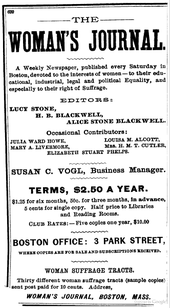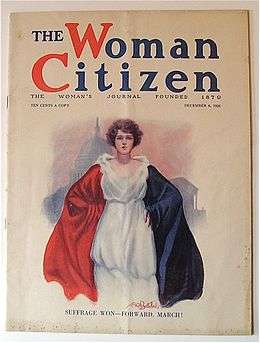Woman's Journal
|
March 8, 1913 front page of the Woman's Journal and Suffrage News depicting the Woman Suffrage Parade of 1913 | |
| Type | Weekly newspaper |
|---|---|
| Format | Broadsheet |
| Owner(s) | Leslie Woman Suffrage Commission (1917-1931) |
| Founder(s) |
Lucy Stone Henry Browne Blackwell |
| Founded | January 8, 1870 (Boston, Massachusetts) |
| Ceased publication | June 1931 |
| Circulation | 27,634 (1915) |
Woman's Journal was an American women's rights periodical published from 1870-1931. It was founded in 1870 in Boston, Massachusetts, by Lucy Stone and her husband Henry Browne Blackwell as a weekly newspaper. In 1917 it was purchased by Carrie Chapman Catt's Leslie Woman Suffrage Commission and merged with The Woman Voter and National Suffrage News to become known as The Woman Citizen. It served as the official organ of the National American Woman Suffrage Association until 1920, when the organization was reformed as the League of Women Voters, and the Nineteenth Amendment to the United States Constitution was passed granting women the right to vote. Publication of Woman Citizen slowed from weekly, to bi-weekly, to monthly. In 1927, it was renamed The Woman's Journal. It ceased publication in June 1931.
History

Woman's Journal was founded in 1870 in Boston, Massachusetts, by Lucy Stone and her husband Henry Browne Blackwell as a weekly newspaper. The new paper incorporated Mary A. Livermore's The Agitator, as well as a lesser known periodical called the Woman's Advocate.
The first issue was published on January 8, on the two-year anniversary of the first issue of Susan B. Anthony's The Revolution. Stone and Blackwell served as editors, with assistance from Livermore. Julia Ward Howe edited from 1872-1879. The daughter of Stone and Blackwell, Alice Stone Blackwell, began editing in 1883, and took over as sole editor after her father's death in 1909, continuing until 1917. Contributors included Antoinette Brown Blackwell, Mary Johnston, Stephen S. Wise, Zona Gale, Florence Kelley, Witter Bynner, Ben B. Lindsey, Louisa May Alcott and Caroline Bartlett Crane. William Lloyd Garrison was a frequent contributor. Around 1887, headquarters were located in Boston on Park Street.[1]
Woman's Journal refused to carry advertisements for tobacco, liquor, or drugs.
In 1910, Woman's Journal absorbed Progress, the official organ of the National American Woman Suffrage Association (NAWSA). Until 1912, it served in that capacity, at which point it was renamed Woman's Journal and Suffrage News. By 1915, circulation had reached 27,634, up from 2,328 in 1909.
The Woman Citizen

In 1917, Woman's Journal was purchased by Carrie Chapman Catt's Leslie Woman Suffrage Commission for $50,000,[2] and merged with The Woman Voter, the official journal of the Woman Suffrage Party of New York City, and NAWSA's National Suffrage News to become known as The Woman Citizen. It served as NAWSA's official organ until 1920,[3] when NAWSA was reformed as the League of Women Voters, and the Nineteenth Amendment to the United States Constitution was passed granting women the right to vote.
The editor-in-chief of The Woman Citizen was Rose Emmet Young; Alice Stone Blackwell was a contributing editor. Every U.S. Congress member was given a free subscription to the journal. It covered issues such as child labor in addition to women's suffrage. After women won the right to vote, the journal's focus shifted to political education for women.[4] One of the aims of the League of Women Voters was to demonstrate its continued political power, now in the form of large numbers of newly enfranchised voters, and to soften its image in the eyes of women who were wary of radical politics. To that end, the journal courted middle-class female readers. It editorialized in support of the Maternity and Infancy Act of 1921, which was the first major legislation to be passed after the full enfranchisement of women. Readers were urged to support the Act by writing to their representatives and talking to their neighbors about it; one article included step-by-step instructions for finding out the names and addresses of their legislators.[5]
Publication of Woman Citizen slowed from weekly, to bi-weekly, to monthly. In 1927, it was renamed The Woman's Journal. It ceased publication in June 1931.
See also
- American Woman Suffrage Association (AWSA)
- List of suffragists and suffragettes
- List of women's rights activists
- Timeline of women's suffrage
- Timeline of women's rights (other than voting)
- Women's suffrage publications
Notes
- ↑ Boston Almanac & Business Directory. 1887
- ↑ The record of the Leslie woman suffrage commission, inc., 1917-1929, by Rose Young.
- ↑ Library of Congress. American Memory: Votes for Women. One Hundred Years toward Suffrage: An Overview, compiled by E. Susan Barber with additions by Barbara Orbach Natanson. Retrieved on 19 May 2010.
- ↑ "The Woman Citizen". Encyclopædia Britannica. Retrieved 17 March 2016.
- ↑ Pierce, Jennifer Burek (2008). "Science, Advocacy, and 'The Sacred and Intimate Things of Life': Representing Motherhood as a Progressive Era Cause in Women's Magazines". American Periodicals. 18 (1): 69–95. JSTOR 41219787.
Bibliography
- Ryan, Agnes E. The Torch Bearer: A Look Forward and Back at the Woman's Journal, the Organ of the Woman's Movement, 1916
External links
| Wikimedia Commons has media related to Woman's Journal. |
- Woman's Journal in the Harvard Woman's Rights Collection
- Feminist and Women's Periodicals at Stanford
